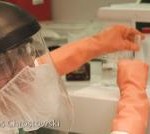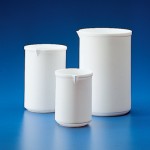 Glass substrate cleaning
Glass substrate cleaning
Glass slides wafers are often cleaned by a solvent clean, followed by a dionized water (DI) rinse, followed by a mild acid clean, DI rinse and blow dry. This is a level-1 process and requires basic INRF safety certification. The use of dangerous chemicals requires that the user may not perform the process alone.
 Glass wet etching
Glass wet etching
This process describes a wet etch for glass with a resulting smooth surface. HF-based etches usually result in rough surfaces, but this recipe provides a smooth surface. The etch quality is also a function of glass quality. This is a level-1 process and requires basic INRF safety certification. The use of dangerous chemicals requires that the user may not perform the process alone.
 Gold etch using potassium iodide solution
Gold etch using potassium iodide solution
This process etches gold by using Potassium Iodide (KI) solution.
 BOE (Buffered Oxide Etch) and HF dip
BOE (Buffered Oxide Etch) and HF dip
Dilute hydrofluoric acid (HF) is used to remove native silicon dioxide from wafers. Since it acts quickly, one needs to only expose the wafer for a short time (“dip”). HF is a dangerous chemical and protective gear must be worn when using it, in particular, neoprene or thick nitrile gloves and eye protection must be worn. This note describes how to prepare a 2% solution. This is a level-1 process and requires basic INRF safety certification. The use of dangerous chemicals requires that the user may not perform the process alone.
 Piranha etch
Piranha etch
This SOP is a MUST-KNOW for the users who potentially use the Piranha solution at the wetbench. Piranha solution is a mixture of concentrated sulphuric acid (H2SO4) and hydrogen peroxide (H2O2), and used for removing organic residues on the semiconductor wafer. This solution is VERY VERY energetic and extreme caution must be taken when preparing, handling and disposing it.
 RCA-1 Si wafer cleaning
RCA-1 Si wafer cleaning
The famous RCA-1 clean (sometimes called “standard clean-1”, SC-1), developed by Werner Kern at RCA laboratories in the late 1960’s, is a procedure for removing organic residue and films from silicon wafers. The decontamination works based on sequential oxidative desorption and complexing with H2O2-NH4OH-H2O (RCA1). A second RCA-2 clean (SC-2) is often used H2O2-HCl-H2O to further clean the surface. RCA-1 clean is used to remove organic residues from silicon wafers.
 RCA-2 Si wafer cleaning
RCA-2 Si wafer cleaning
The famous RCA-2 clean (sometimes called “standard clean-2”, SC-2), developed by Werner Kern at RCA laboratories in the late 1960’s, is a procedure for removing metal ions from silicon wafers. The decontamination works based on sequential oxidative desorption and complexing with H2O2-HCl-H2O (RCA-2). Typically this is preceded by an RCA-1 clean (SC-1, H2O2-NH4OH-H2O) to remove organic residues. In the process, it oxidizes the silicon and leaves a thin oxide on the surface of the wafer.
 Si anisotropic etch (KOH, TMAH)
Si anisotropic etch (KOH, TMAH)
KOH is a wet etch which attacks silicon preferentially in the <100> plane, producing a characteristic anisotropic V-etch, with sidewalls that form a 54.7° angle with the surface (35.3° from the normal). This etch process is independent of the doping concentration for As, P and Sb. For B, the <110> etch rate drops quickly at high doping concentrations. This is a level-1 process and requires basic INRF safety certification. The use of dangerous chemicals requires that the user may not perform the process alone.
 Si isotropic etch (HNA)
Si isotropic etch (HNA)
HNA (hydrofluoric, nitric, acetic) is an extremely aggressive acidic mixture which will vigorously attack silicon. It is an isotropic wet etchant which etches silicon at a rate of approximately 1-3 microns per minute (using the formula in this document). This is a level-1 process and requires basic INRF safety certification. The use of dangerous chemicals requires that the user may not perform the process alone.
 Si wafer cleaning
Si wafer cleaning
Silicon wafers are cleaned by a solvent clean, followed by a dionized water (DI) rinse, followed by an RCA clean and DI rinse, followed by an HF dip and DI rinse and blow dry. This is a level-1 process and requires basic INRF safety certification. The use of dangerous chemicals requires that the user may not perform the process alone.